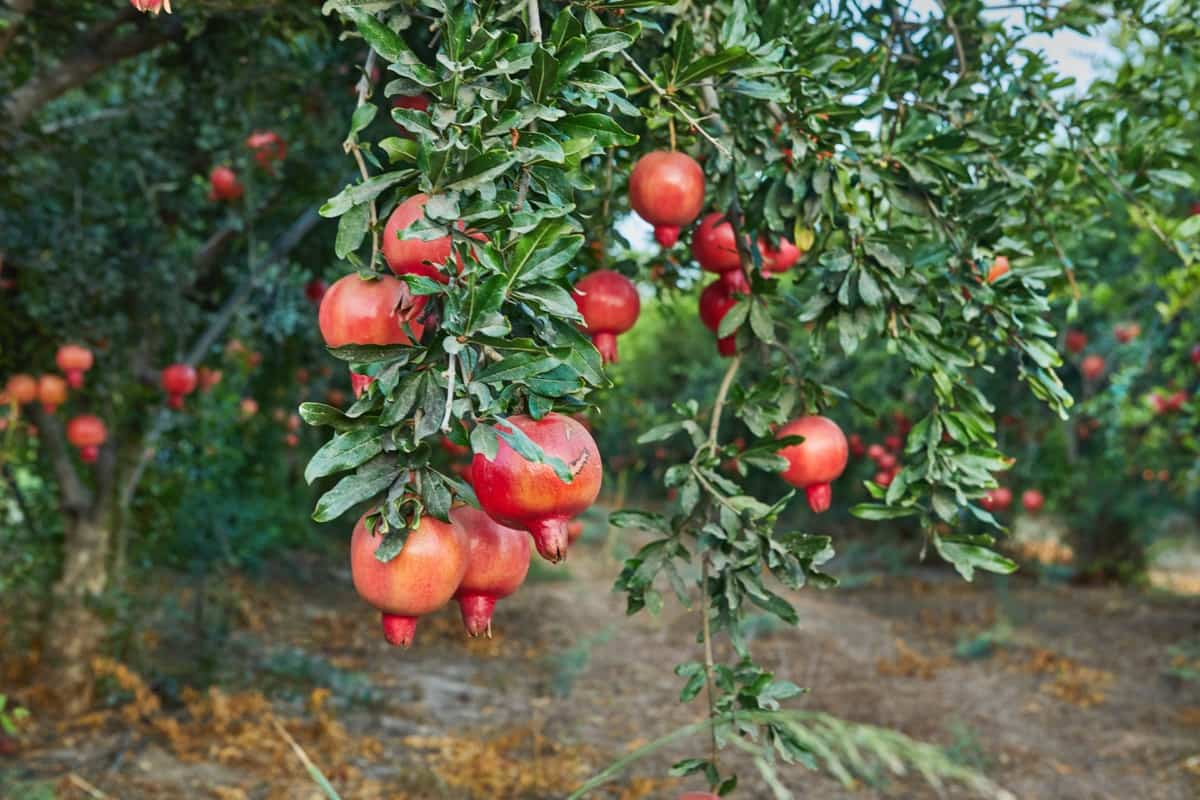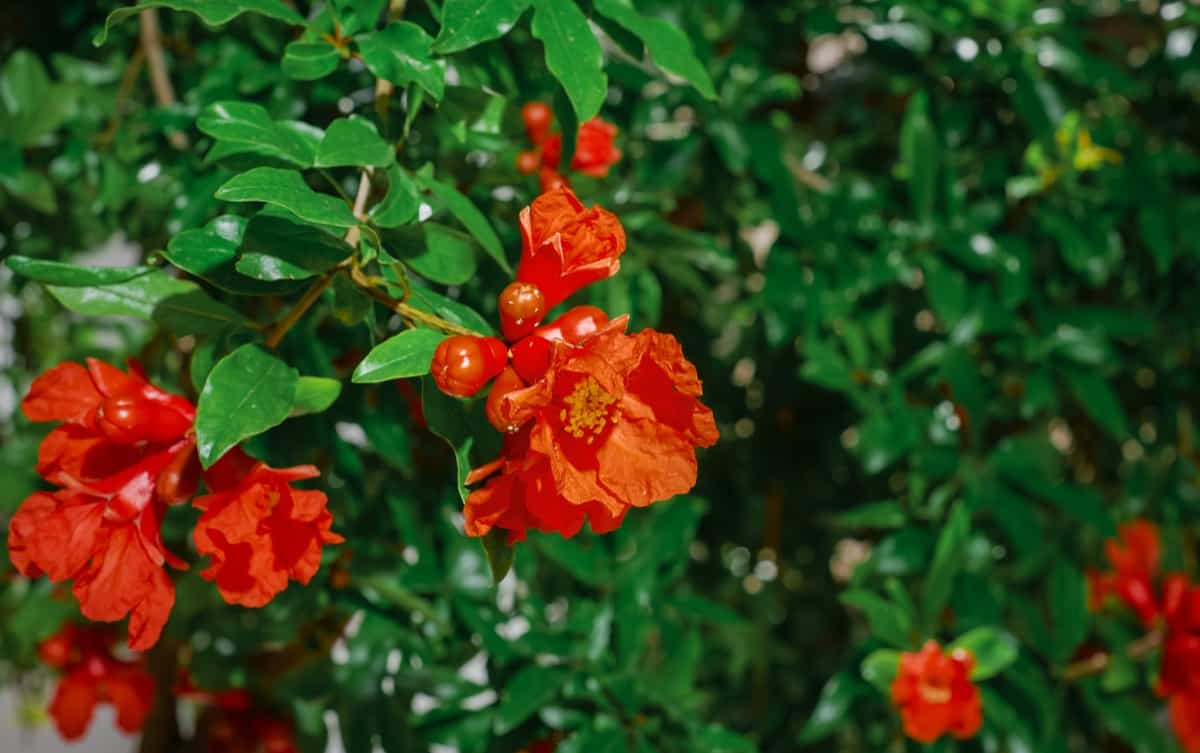Pomegranate trees are known for their vibrant and delicious fruits. To ensure a successful yield, it is important to understand the pollination process. In this guide, we will explore two methods of pollinating pomegranate flowers: hand and natural. Additionally, we will provide some tips to help you maximize your pomegranate harvest.

How to Pollinate Pomegranate Flowers
Step-By-Step Guide to Pollinating Pomegranate Flowers
- Pomegranate flowers are receptive to pollination for a limited period, usually in the morning. Identifying this window of opportunity is important to maximize the chances of successful pollination.
- Choose flowers that are healthy and have fully opened petals. Avoid damaged or wilted flowers, as they may not be suitable for hand pollination.
- Gently tap the flower’s anthers to release the pollen onto a clean, dry surface. You can use a small brush or a cotton swab to collect the pollen. Make sure to handle the pollen carefully to avoid damaging it.
- Once you have collected the pollen, carefully transfer it to the stigma of another flower. The stigma is the female reproductive part of the flower, located at the center. Gently brush the stigma with the collected pollen to ensure effective pollination.
- Repeat the process of collecting pollen and transferring it to the stigmas of other flowers. This will increase the chances of pollination and fruit set.
- After pollination, protect the flowers from any disturbances. Avoid excessive watering or touching the flowers, which can disrupt pollination.
- Monitor the pollinated flowers regularly to ensure proper fruit development. Provide adequate water and nutrients to support the growth of the developing fruits.
Methods for Hand Pollination of Pomegranate Flowers
You can pollinate the flowers by using an artist’s paintbrush to collect and transfer the pollen from the stamen to the female ovary. Lightly rub the brush on the male stamen and then rub the brush onto the female flower. Repeat it for 2-3 days. You can pollinate more than one female flower from a single male flower of the same tree or a different tree.
In case you missed it: How to Pant, Grow and Care for Bonsai Pomegranate

Natural Pollination Techniques for Pomegranate Flowers
Using Natural Pollinators
Bees are efficient pollinators and can significantly improve fruit set and yield. Pomegranate flowers attract bees due to their bright color and abundant nectar. Attracting bees to the garden or orchard can enhance the chances of successful pollination.
Pollination By Wind
Another natural pollination technique is wind pollination. The movement of the wind helps transfer the pollen from the stamen to the stigma, resulting in pollination. Ensure proper spacing between pomegranate trees or shrubs to facilitate wind pollination, allowing for adequate air circulation.
Hand Pollination
This technique involves manually transferring pollen from the stamen to the stigma using a small brush or cotton swab. Hand pollination is particularly useful when there is a shortage of pollinators or when specific varieties require cross-pollination for fruit set.
Tools and Equipment Needed for Pollinating Pomegranate Flowers
- Paintbrush or Feather: For transferring pollen from one flower to another.
- Pollen Collection Container: For collecting and storing pollen.
- Labeling Tags: For keeping track of the different pomegranate varieties and their corresponding flowers.
- Zip Ties or Twist Ties: For securing the labeling tags to the branches or stems
- Pruning Shears: For trimming excess foliage or branches that may obstruct access to the flowers.
- Magnifying Glass or Hand Lens: For observing the pomegranate flowers up close.
- Gloves: To maintain cleanliness and prevents the transfer of contaminants
- Disinfectant Solution: To minimize the risk of spreading diseases or pathogens, clean the tools before and after each use.
Understanding the Pollination Process in Pomegranate Flowers
The pomegranate flower has a unique structure that aids in its pollination process. It possesses multiple stigmas arranged in a star-like pattern, surrounded by a ring of anthers. This arrangement ensures that as bees land on the flower, their bodies come into contact with both the anthers and the stigmas, increasing the chances of successful pollination.
In case you missed it: Project Report of 1-Acre Pomegranate Farming: Production Economics, and Cultivation Cost and Profit Analysis

Once the pollen is deposited on the stigma, they germinate and grow pollen tubes, which penetrate the style, a long tube-like structure that connects the stigma to the ovary. These pollen tubes then deliver the male gametes to the ovules within the ovary, resulting in fertilization. Successful pollination in pomegranate flowers leads to the development of fruits. Each fertilized ovule within the ovary develops into a seed, surrounded by juicy arils.
Tips for Successful Pollination of Pomegranate Flowers
- Encourage bee activity: To attract bees, plant flowers that act as bee magnets, such as lavender or marigolds, near your pomegranate trees. Bees will visit these flowers and then pollinate your pomegranate flowers.
- Monitor Environmental Conditions: Avoid extreme weather conditions such as frost, high winds, or excessive heat, as they can negatively impact pollen viability and flower receptivity.
- Prune for Optimal Air Circulation: Proper pruning can help improve air circulation within the pomegranate tree, enhancing pollen transfer. Remove any dead or overcrowded branches to allow better access for pollinators and increase sunlight exposure.
- Hand Pollination Techniques: If natural pollinators are limited, you can manually transfer pollen from one flower to another using a small, fine paintbrush or cotton swab.
Common Challenges in Pollinating Pomegranate Flowers and How to Overcome Them
- In some areas, there may be a shortage of pollinators, leading to poor fruit set. To overcome this challenge, encourage the presence of pollinators by providing wildflower strips or nesting sites for solitary bees.
- Pomegranate flowers do not all bloom at once, making it difficult for pollinators to transfer pollen from one flower to another efficiently. To overcome this challenge, inspect the flowers daily and note when most flowers are in full bloom. Once this timing is identified, pollinators can be introduced to the orchard.
- Pomegranate flowers can self-pollinate, but the resulting fruit may have reduced quality and size compared to cross-pollinated fruit. To overcome this, manually transfer the pollen from one flower to another using a small brush or cotton swab.
- Environmental factors like extreme temperatures or adverse weather conditions can also challenge pomegranate pollination. To mitigate these, provide shade or use shade cloth during intense heat, protecting the orchard from strong winds or heavy rains.
Timing and Frequency of Pollination in Pomegranate Flowers
Pomegranate flowers are receptive to pollen for a limited period, usually lasting for a few days. The exact timing varies depending on the cultivar and environmental conditions. Identifying the peak period of pollen viability and flower receptivity is crucial to ensure effective pollination.
In case you missed it: 9 Causes of Dying Pomegranate Tree and How to Fix It?

The pollination frequency depends on the flowering period’s duration and pollinators’ activity. Pomegranate flowers usually last about 2 to 3 days, during which they are receptive to pollen. To ensure optimal pollination, it is recommended to have frequent visits from pollinators throughout the flowering period.
Conclusion
By understanding and implementing proper pollination techniques and following these tips, you can help ensure a bountiful pomegranate harvest. Enjoy the process and the reward of growing your delicious pomegranates!
- Feed Your Flock for Less: Top 10 Tips to Save on Chicken Feed
- Ultimate Guide to Ossabaw Island Hog: Breeding, Raising, Diet, and Care
- Hatching Answers: The Top 10 Reasons Your Chickens Aren’t Laying Eggs
- Eggs and Economics: Breaking Down the Cost of Raising Backyard Chickens
- Defend Your Greens: Proven Methods to Keep Iguanas Out of Your Garden
- Ultimate Guide to Cinnamon Queen Chicken: A Comprehensive Guide for Beginners
- Ultimate Guide to California Tan Chicken: Breeding, Raising, Diet, Egg-Production and Care
- Ultimate Guide to Marsh Daisy Chicken: Breeding, Raising, Diet, and Care
- 10 Types of Chicken Farming Businesses You Can Start for Profits